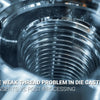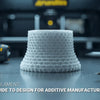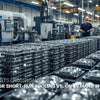Die Casting Manufacturing Process:A Comprehensive Guide
Die Casting Manufacturing Process: A Comprehensive Guide
What is Die Casting?
Die casting is a versatile and cost-effective manufacturing process used to create metal parts by forcing molten metal under high pressure into a mold cavity. This method is popular for producing large quantities of parts with excellent dimensional accuracy, sharp detail, and smooth or textured surfaces. Whether you are in the automotive, aerospace, electronics, or consumer goods industry, die casting can be your go-to solution for high-quality metal components.
The History of Die Casting
Early Innovations
The origins of die-casting can be traced back to the mid-19th century when the first patents for die-casting processes were submitted. Originally developed for the printing industry to cast movable type, these early methods were crude by today's standards but laid the groundwork for more sophisticated techniques. Fast forward to the early 20th century, and die casting began to see significant improvements with the advent of new materials and more advanced machinery.
Modern Developments
With the invention of modern alloys and the development of automated die-casting machines, the industry experienced rapid growth. Today, die casting has evolved into a highly efficient and precise process, capable of producing complex shapes and designs with minimal waste. Modern die casting utilizes computer-aided design (CAD) and computer-aided manufacturing (CAM) to ensure precision and repeatability, making it an integral part of many manufacturing sectors.
The Die Casting Process Explained
Die casting involves several critical steps that ensure the final product meets exact specifications and quality standards.
Step 1: Mold Preparation
Before casting any metal, the mold must be prepared. This step is crucial as it determines the final shape, surface finish, and dimensional accuracy of the cast part.
Types of Die-Casting Molds
There are two primary types of molds used in die casting: permanent molds and expendable molds. Permanent molds, made from durable metals like tool steel, are used for high-volume production runs because they can be reused thousands of times. Expendable molds, made from materials like sand or plaster, are used for more complex shapes or lower-volume production runs.
Mold Design and Maintenance
Mold design is a specialized field that requires a deep understanding of materials, heat transfer, and metal flow dynamics. Proper mold maintenance, including regular cleaning and inspection, is essential to prevent defects in the final product and to extend the life of the mold.
Step 2: Injection Process
Once the mold is prepared, the molten metal is injected into it under high pressure. This step is where the magic happens, transforming liquid metal into a solid, intricately shaped component.
Hot Chamber vs. Cold Chamber Die Casting
There are two main types of die-casting processes: hot chamber and cold chamber. In hot chamber die casting, the injection mechanism is submerged in molten metal, making it ideal for low-melting-point alloys like zinc and magnesium. Cold chamber die casting, on the other hand, requires the molten metal to be ladled into the injection chamber, making it suitable for metals with higher melting points like aluminum and copper.
Step 3: Cooling and Solidification
After injecting the metal, it needs time to cool and solidify in the mold. Cooling is a critical step because it determines the metallurgical properties of the final product. Too rapid cooling can lead to internal stresses and cracks, while too slow cooling can result in poor mechanical properties.
Step 4: Ejection and Trimming
Once the metal has solidified, the mold is opened, and the part is ejected. This step is followed by trimming, where any excess material or flash is removed. Trimming is typically done using a mechanical press or manually, depending on the complexity and size of the part.
Types of Die Casting Methods
Die casting isn't a one-size-fits-all process. There are various methods, each suited to different materials, part complexities, and production volumes.
Gravity Die Casting
Gravity die casting, also known as permanent mold casting, relies on gravity to fill the mold with molten metal. This method is often used for simpler shapes and is known for producing parts with good dimensional accuracy and a high-quality surface finish.
Pressure Die Casting
Pressure die casting involves forcing molten metal into a mold under high pressure. This category can be further divided into high-pressure and low-pressure die casting.
High-Pressure Die Casting
High-pressure die casting is the most common method, especially for producing large quantities of small to medium-sized parts. The high pressure ensures that the molten metal fills even the most intricate parts of the mold, resulting in precise, detailed components.
Low-Pressure Die Casting
Low-pressure die casting uses a lower injection pressure, which is ideal for producing parts with less complex geometries or where high strength isn't as critical. This method is often used for larger, thicker parts that require a high-quality surface finish and fewer internal defects.
Materials Used in Die Casting
Different materials are used in die casting, each offering unique properties that make them suitable for specific applications.
Aluminum
Aluminum is one of the most commonly used materials in die casting due to its lightweight, excellent corrosion resistance, and good thermal conductivity. It's widely used in the automotive and aerospace industries for parts like engine blocks, transmission housings, and structural components.
Zinc
Zinc is another popular die-casting material, valued for its excellent mechanical properties and the ability to create very thin walls in cast parts. It's often used to produce small, intricate components like connectors, gears, and fittings.
Magnesium
Magnesium is the lightest structural metal and has excellent strength-to-weight ratios. It is used in applications where weight reduction is critical, such as in automotive and aerospace components.
Advantages of Die Casting
Die casting offers numerous benefits, making it a preferred choice for many manufacturing needs. The process is highly efficient and can produce large quantities of parts in a short time. Die-cast parts are also durable and can have complex shapes with tight tolerances, eliminating the need for additional machining.
Common Applications of Die Casting
Die casting is used across a wide range of industries, including automotive, aerospace, electronics, and consumer goods. Common applications include engine components, housing parts, heat sinks, and even decorative items like doorknobs and handles.
Quality Control in Die Casting
Quality control is a crucial aspect of die casting, ensuring that every part meets the required standards. This includes dimensional inspections, non-destructive testing methods like X-ray and ultrasound, and mechanical property testing to verify strength, hardness, and ductility.
Future Trends in Die Casting
The die-casting industry continues to evolve with new technologies and trends.
Automation and AI
Automation and artificial intelligence (AI) are revolutionizing die casting by improving process control, reducing defects, and increasing efficiency. Robotic systems are increasingly used for mold handling, metal pouring, and part inspection.
Sustainable Practices
Sustainability is becoming more important in die casting, with efforts focused on reducing waste, recycling materials, and minimizing energy consumption. New developments in eco-friendly alloys and energy-efficient machinery are paving the way for a more sustainable future in die casting.
Conclusion
Die casting is a powerful manufacturing process that offers unparalleled precision, efficiency, and versatility. From its humble beginnings to its current status as a cornerstone of modern manufacturing, die casting has continuously evolved to meet the demands of various industries. As technology advances and new materials emerge, the future of die casting looks brighter than ever, promising even more innovative applications and sustainable practices.





